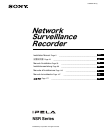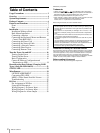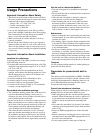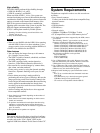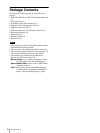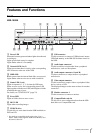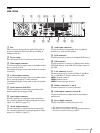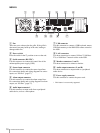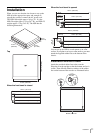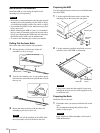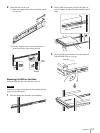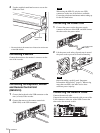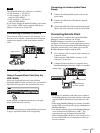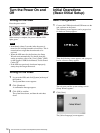
Overview
4
• When placing the unit on a floor or other surface,
make sure that the unit is equipped with the specified
rubber feet, and put the unit down carefully. If there
are no feet, mount the rubber feet first. Do not place
the unit near other devices that may become a source
of vibrations.
Wait for 30 seconds after turning power off
For a brief interval after the power is turned off, the
platters inside the HDD will still keep spinning and the
heads will be in an insecure position. During this
interval, the unit is more susceptible to shocks and
vibrations than during normal operation. For a period of
at least 30 seconds after turning power off, avoid
subjecting the unit even to very light shocks. After this
period, the hard disk will be fully stopped and the unit
can be manipulated.
Temperature and humidity related precautions
Use and store the unit only in locations where the
specified temperature and humidity ranges are not
exceeded.
Temperature range for operation: +5 to +40 ºC
(+41 to +104 ºF)
Humidity range for operation: 20 to 80% relative
humidity (maximum wet-bulb temperature 30 ºC/
86 ºF, no condensation)
Temperature range for storage: –20 to +60 ºC
(–4 to +140 ºF)
Humidity range for storage: 20 to 90% relative
humidity (maximum wet-bulb temperature 40 ºC/
104 ºF, no condensation)
When HDD seems to be faulty
Even if the HDD is showing signs of malfunction, be
sure to observe all the above precautions. This will
prevent further damage from occurring until the problem
can be diagnosed and corrected.
HDD replacement
The HDD, fan, and battery of the unit are consumable
parts that will need periodic replacement. When
operating at room temperature, a normal replacement
cycle will be about two to three years. However, this
represents only a general guideline and does not imply
that the life expectancy of these parts is guaranteed.
Regarding parts replacement, consult your supplier.
Overview
The NSR series is a hard disk recorder for network
cameras. The NSR allows you to monitor and record
network camera images (JPEG or MPEG-4). It also
allows you to play back the recorded images and search
through it, making the NSR a truly versatile monitoring
system.
Control compatible cameras from remote
locations
You can pan, tilt, and perform zoom operations of
compatible cameras.
Compatible with analog cameras
You can monitor and record images from analog
cameras when you purchase and install an optional
camera server (SNT-V704).
Large-capacity hard disks allow recording for
long periods of time
The
NSR
is equipped with large-capacity hard disks. The
NSR-100 can record up to approximately 920 GB
1)
of data,
the NSR-50 can record up to approximately 460 GB
1)
of
data, and the NSR-25 can record up to approximately 230
GB
1)
of data. For example, if you record images from 16
cameras at 1 fps
2)
VGA, JPEG; one frame equals about 31
KB) with the NSR-100, you can record approximately a
month’s worth of images (15 hours a day)
3)
1) Includes the database capacity managed by the internal
software.
2) fps: frames per second.
3) When set to RAID 0.
Slim type (2U), space-saving 19-inch rack
mounting model
With the optional rack mounting kit (sold separately),
the unit can be installed in a standard universal pitch EIA
19-inch rack.
High-resolution up to 480 fps (VGA, JPEG)
recording
The NSR-100 can support up to 64 cameras, the NSR-50
can support up to 32 cameras, and the NSR-25 can
support up to 20 cameras. The NSR-100 records images
at a total frame rate of 480 fps* (240 fps with the
NSR-50, 120 fps with the NSR-25), VGA (640 × 480
pixels) resolution, JPEG (1 frame approx. 31 KB) image
format, for a crisp image quality.
* Maximum frame rate when 16 cameras are connected to the
recorder. Each camera has a frame rate of approximately 30
fps. This frame rate may become less because of
fragmentation on the internal hard disks. Values are based
on Sony measurements. These values are not guaranteed, as
performance may change due to the user’s operating
environment.



